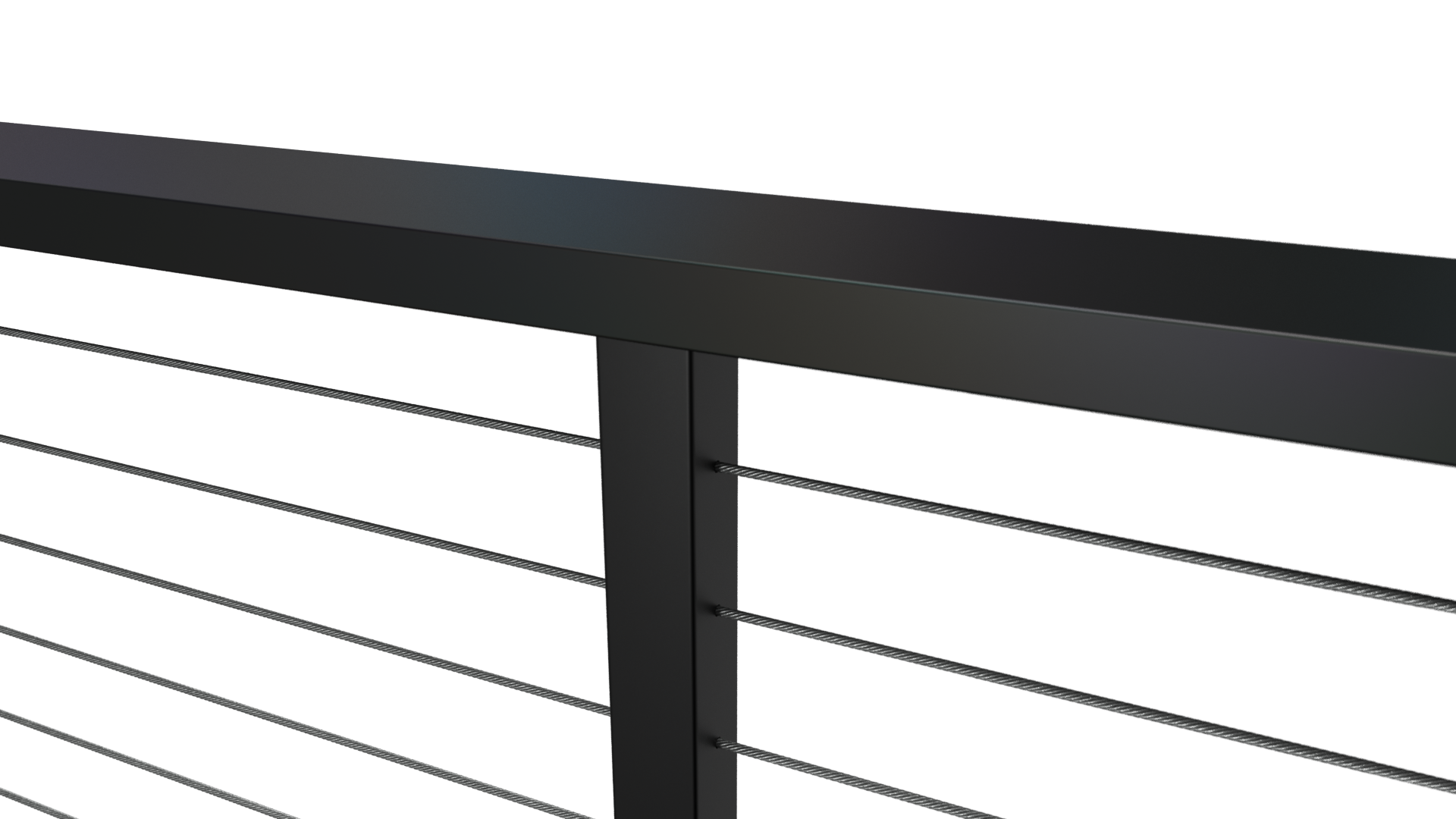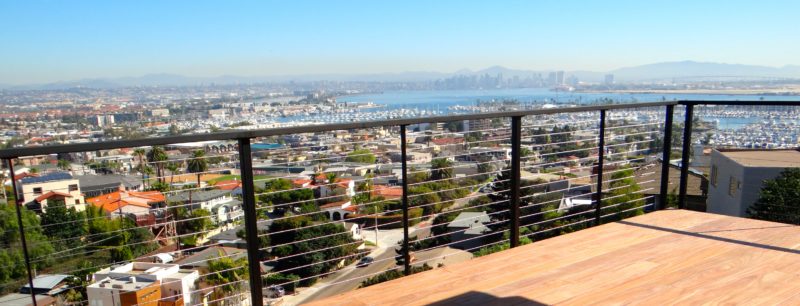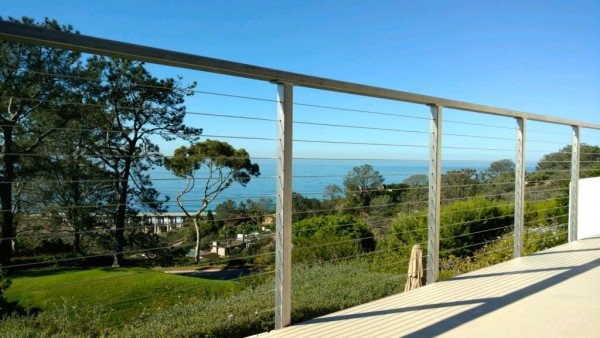




There are several types of interior and exterior railings and railing post types available in today’s marketplace. Reviewing the different mounting types, recommended spacing, materials, colors and applications can be daunting at times. In this post we aim to clarify some of these details and offer some common terminology regarding the most popular railing post types. Most of the reference material is geared towards stainless steel cable and glass railing systems as those make up the majority of our sales and installations. Structural Railing Posts Depending on the type of railing system there may be a single type or many type of posts used to support the infill and top rail. Structural posts refer to those designed to sustain lateral and possibly tension loads within a railing system. An “end post” or a “corner post” within a cable railing system refer to structural railing posts. In comparison, a “spreader post” would not be considered a structural railing post as its purpose is not primarily structural and mainly aesthetic. A common spacing recommendation for structural railing posts is between 4 and 6 feet on center spacing. Cable railings require tighter spacing for structural posts than picket railings due to tension loads and spread. The most common recommendation for cable railing systems is 4′ on center, while glass panels might be 5′ on center, and various picket or rod infill systems can push to the 6′ on center spacing. These are generic guidelines as systems and municipalities vary. Installers should follow recommendations and current codes. Glass Boot and/or Base Shoe Support Systems Although not technically a railing post, base shoes are becoming more and more commonly used for glass railing systems. A “base shoe” or “boot” is secured to the deck surface and acts as a structural clamp and support for heavy duty tempered glass panels. Structurally, a boot system is one of the only secure ways to support glass panels without the use of railing posts. Base shoes are engineered for structural use and support, requiring grout or a special locking system to secure the panels and support system. Recent updates have called out the use of laminated glass more and more often for “no top rail” glass systems. A base shoe mount is a proven way to safely achieve this type of install. Railing posts of different types and sizes can also be used in lieu of base shoe for installing glass panels. Typically glass clips (small clamping mechanism) are attached to structural railing posts in order to secure glass panels for this type of installation. Additionally, there are full framed glass systems which utilize channel and/or full framed glass railing with top and bottom railings and structural posts every 4-5′. Intermediate Posts, Spreader Posts, and Slim Line Railing Posts Intermediate posts like the one photographed above are also called “spreaders” or “line” posts. This type of railing post is often utilized to increase a viewing window without the larger profile of a structural post. As photographed the structural posts are 2″ square while the spreader post is a mere 3/8″ wide profile. The intermediate (spreader) post provides some rigidity and prevents the stainless steel cables from spreading, without the need for the heavy wall or width of a 2″-4″ post. When dealing with cable railings, glass, and other low visibility systems; spread is key to opening the view. When utilizing spreader posts between structural posts, installers can achieve clear windows of 6-7 feet without fear of code compliance or stability issues. Additional Notes on Railing Posts and Terminology Consumers should note that railings and fencing are very different when it comes to spans and spacing. There are many photographs found online that illustrate posts, pegs, clips, and all different kinds of spacing that may or may not satisfy code requirements for a safety railing. Just because photos exist, does not mean it will satisfy an inspection. Windbreaks and fencing may not require the same safety measures as a second story deck. Railings with and without top railing members will often have different rules and code requirements. Our company (San Diego Cable Railings) has been furnishing railing kits to homeowners and builders nationwide since 2009. We furnish a variety of railing posts for cable, glass, rod, and horizontal panel systems. Our welded connections and high grade stainless posts have been engineered to satisfy loading requirements, and even our spreader posts provide unmatched strength and elegance for your home. If you have questions about any of our railing post types or would like to obtain pricing for a railing system, give us a call or visit the quote request form today.
If you’re building a deck and researching cable railings; you may be wondering what type of railing posts would be best for your installation. With so many products available online, it can be difficult to decide. We hope to make it easier with some information and recommendations about material selection and cable railing post types for all kinds of projects. Using Wooden Posts to Construct Cable Railings One of the most widely used and commonly known post type is a wooden 4″x4″. This is an inexpensive and widely available post option for most people. Wood posts are very easy to install. One drawback to using wood posts is sustaining cable tension. Softwoods like cedar and redwood can be the most difficult of all the cable railing post types. Wood swells and shrinks in different weather, making it difficult to maintain tension. We recommend the use of hardwoods like Ipe’ and Cumaru if wooden posts are your preferred choice. Hardwoods are stronger and behave more like a steel railing frame. Steel and Stainless Steel Railing Posts Coastal and harsh weather environments call for extremely durable railing materials. From a pure longevity standpoint, steel and stainless steel posts are some of our top choices. When salt is present, high grade stainless steel is a must. For non salt applications, galvanized steel will offer a 30 year lifespan. The addition of exterior coatings like epoxy paints can extend the durability to 50 years. Steel and stainless steel railing posts can satisfy many design styles. These materials also afford the ability for the most minimal railing profiles. Spreader Posts and Specialty Railing Post Types The use of “intermediate” or “spreader” posts is a popular method for reducing cable spread and also minimizing visible obstruction. These posts are low profile and usually made from flat bar or low profile tube steel. It’s important to remember that spreader posts are not structural. They should not be used as end or corner posts because of their light duty nature. Aluminum Cable Railing Posts Because aluminum is a lightweight material, it can require slightly larger posts or the use of top and bottom rails. Aluminum railing systems like Feeney Design rail, may utilize a combination of end posts and spreader posts to reduce cable spread. Aluminum is very durable, therefore making it a good choice for coastal railings and longevity. San Diego Cable Railings offers all of the cable railing post types discussed in this article. Our company has a line of engineered cable railing posts as well as specialty posts like flat bar spreaders. If you are interested in our products, please give us a call at 844-277-7327 or visit the quote request page.

Post selection is an important part of any deck and railing design. Structural posts, intermediate pickets, and spreader posts each have unique applications. Here are some tips to help you decide which types of posts are right for your cable railing project: Structural posts are used as the support posts of any railing frame. Pertaining to cable railings, end posts and corner posts are both examples of structural railing posts. Wood, steel, stainless steel, and aluminum are common material selections for structural posts. Cable railing systems typically feature a cable count between 10 and 13 cables. When tension is applied to these cables, the majority of the tension load will be carried by the corner and end posts. For this reason, only posts that are designed to carry these type of loads should be used in these locations. Structural posts support the top railing, sustain tension, and are typically attached with bolts or concrete anchors in order to resist heavy loads. Intermediate Pickets can be utilized in order to reduce cable spread and provide a tighter post spacing with a minimized post profile. Intermediate pickets are usually made of stainless steel or aluminum tube with a 3/4″ to 1″ profile. Picket posts are placed in between structural posts with the primary purpose of reduced cable spread. Picket style posts are not usually suitable for use as support posts, however they do provide some upright support for the top railings. Intermediate pickets will allow the user to space the structural railing posts farther apart, and because of a thinner profile they should not negatively affect visibility. SDCR Intermediate Picket Posts will provide great lateral stability because of the steel construction and welded plate connections. Spreader Posts are another example of an intermediate post option that will reduce cable spread and allow for larger distances in between structural posts. SDCR “ultra slim” spreader posts are custom made flat bar posts that feature the most minimal profile available. Spreader posts are almost always made from steel or stainless steel flat bar, although we have on occasion made them from hardwood/s. Flat bar provides a very sleek look and maximum visibility. Due to the custom nature of our spreader posts, the price point for these posts is higher than a picket style post. Spreader posts are a great option for coastal applications and ocean view railings. For more information on our line up of railing posts give us a call at 844-277-7327 or click on the product links below: [ec_store groupid=”7″]

Disappearing Guardrails Using Stainless Steel Cable Railings- Cable Railing customers often request recommendations for the most “invisible” or “transparent” color selections when choosing a railing package. Opinions from different online sources will vary when it comes to this topic, however after constructing hundreds of decks and railings with all different types of backdrops we believe there are some clear choices. The most transparent railings will offer the fewest solid members and feature minimal profiles. Post and railing finishes should be muted, avoiding heavy solid colors and reflective surfaces. Disappearing guardrails will blend into surrounding landscapes of all different types and colors, and pick up or reflect hues from trees and shrubs. The same parameters must be met when dealing with coastal settings where transparency is usually the #1 factor for choosing a railing system. For our coastal and landscape railings and fencing, the clear choice is bare stainless steel. Much like stainless steel cables, bare stainless steel railing posts and rails pick up colors from the existing landscape and reflect their surroundings. When combined with stainless steel or hardwood top railings our bare stainless cable railing posts are the most utilized finish option for transparency. SDCR stainless posts are furnished with a non reflective clean matte finish which offers the beauty and durability of stainless steel. Bare stainless features neutral grey tones with a slight sparkle; no concerns about fingerprints or other drawbacks associated with polished finishes. For maximum daylight openings with the least amount of visible obstruction, “ultra slim” stainless steel spreader posts can be utilized in between structural posts. The use of spreader posts will allow the installer to space structural posts up to 7′ for a wide open view and feel. We also offer powder coating to all of our stainless steel post options, usually recommending a neutral tone like medium grey when transparency is a must. Despite some popular articles and design theories about black railing posts for transparency; we have found black to be more visible during daylight hours in addition to drawing more UV rays. Stainless Steel Cable Railings are transparent even at close range with high resolution cameras, with no glass to clean or maintenance issues offered by other railing types. If you have questions about our bare stainless steel product line, give us a call at 844-277-7327 and speak with one of our cable railing pros 8am-5pm mon-fri.
Summer is here and deck season is upon us! San Diego Cable Railings is running a special priced offer on Overstock Cable Railing Posts at just $99 each. Overstock posts are easy to install and compatible with all of our most popular DIY cable assemblies. Pre-drilled and pre-finished, these railing posts are perfect for deck railings, cable fencing and interior cable railing applications. While supplies last we will be featuring a special on 42″ surface mounted railing posts in our most popular “stainless steel” powder coated finish. Made from galvanized steel and utilizing welded mounting plates, these railing posts are a durable and cost effective way to install a variety of cable railing options. Overstock Cable Railing Posts are compatible with wooden or steel top railings, and can be bolted directly to a floor or deck surface. For more information on overstock specials please click on the link or give us a call at [ut_button color=”red” target=”_self” size=”small” ]844-277-7327 [/ut_button] and speak with one of our cable railing professionals. [ec_product productid=”275″ style=”1″]